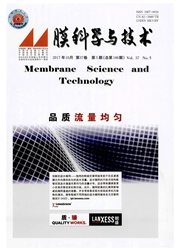

 中文摘要:
中文摘要:
通过浸没沉淀相转化法制备生物基聚乳酸(PLLA)微孔膜,并考察溶剂种类和致孔剂种类及致孔剂分子量对微孔膜结构和性能的影响.分别考察N-甲基吡咯烷酮(NMP)、N,N-二甲基乙酰胺(DMAc)和1,4-二氧六环(DO)作为溶剂对PLLA膜微孔结构的影响,研究用聚乙二醇(PEG6000)和聚乙烯基吡咯烷酮(PVP_K30)作为致孔剂对PLLA膜微孔结构、平均孔径、水通量及接触角的影响;不同分子量的致孔剂PEG(600、6000、10000)对PLLA膜微孔结构、平均孔径及水通量的影响.通过扫描电镜照片发现,NMP和DMAc作为溶剂可得到指状孔,而D()作为溶剂得到胞状孔,PEG和PVP—K30作为致孔剂均可促进PLLA膜大孔的形成,PVP—K30可使PLLA膜表面更为多孔,不同分子量的PEG作为致孔剂会同时影响PLLA膜的孔径和皮层厚度.通过对制备的PLLA微孔膜的水通量及尿素、溶菌酶和牛血清蛋白的透过性能分析表明聚乳酸膜具有较好的溶质选择透过性,有望成为具有良好生物相容性和透析性能的新一代血液透析膜材料.
 英文摘要:
英文摘要:
Bio-based poly (L-lactic acid) (PLLA) for dialysis was prepared via immersion precipitation method in this work. The influences of the solvent including N-methyl pyrrolidone (NMP), N, N- dimethyl acetamide (DMAc) and 1, 4-dioxane on the micro-structures of PLLA membrane, the influences of the pore former including polyethylene glycol (PEG6000) and polyvinyl pyrrolidone (PVP) on membrane morphologies, pore size, pure water flux and contact angle, and furthermore, the influences of polyethylene glycol with different molecular weight (e. g. PEG600, PEG6000 and PEG10000) on membrane morphologies, pore size, pure water flux were investigated. SEM pictures showed that both NMP and DMAc could produce finger-like pores for PLLA membrane, while 1, 4-dioxane could cause the formation of cellular pores. PVP-K30 can make a more porous surface than PEG6000. PEG with different molecular weights affected both the pore size and the surface layer thickness of PLLA film. The retention of PLLA membrane to urea, lysozymer and BSA was studied. All results indicat that bio-based PLLA membrane is promising to be the next generation of dialysis membrane with good bio-compatibility.
 同期刊论文项目
同期刊论文项目
 同项目期刊论文
同项目期刊论文
 期刊信息
期刊信息
